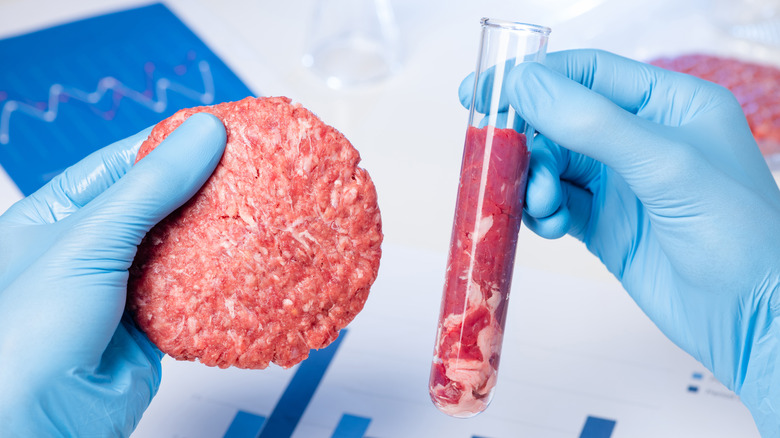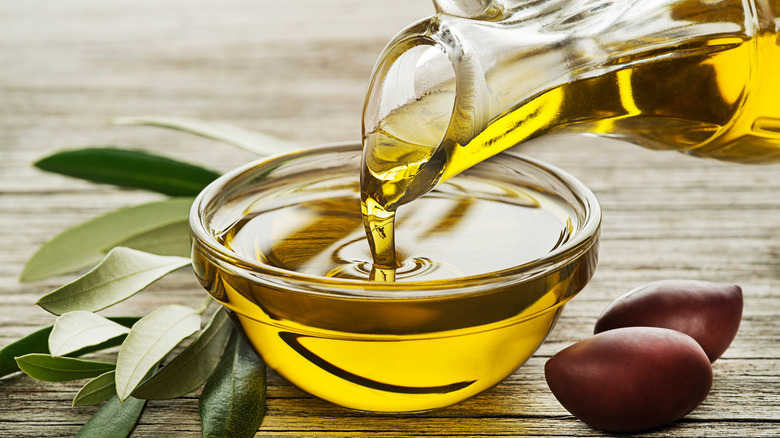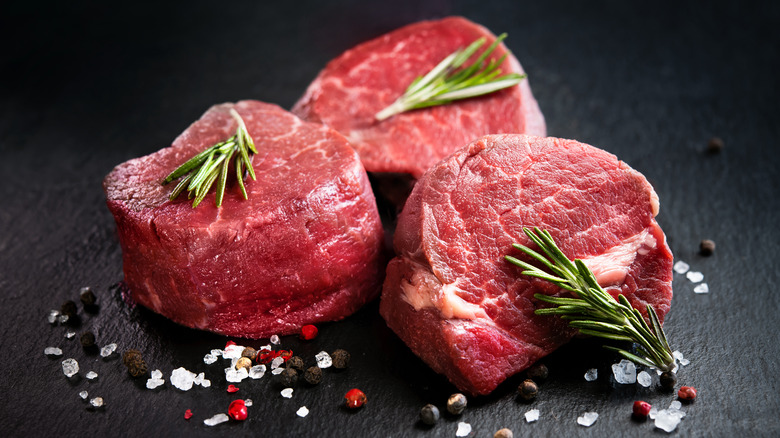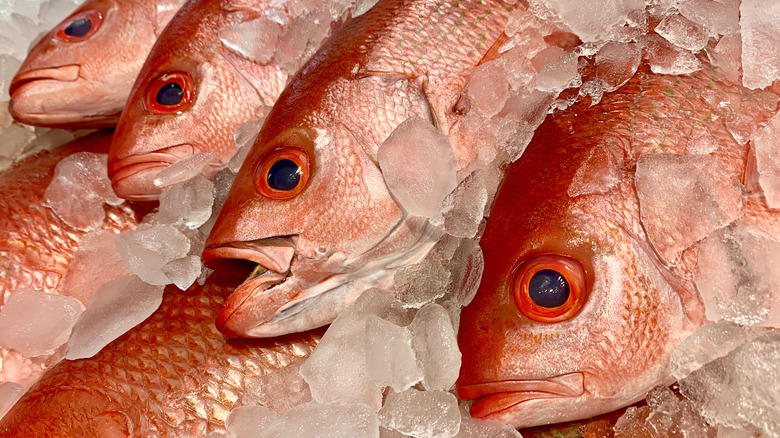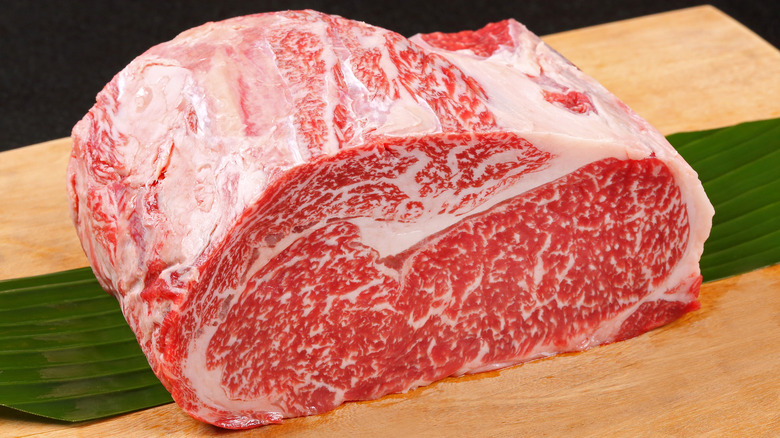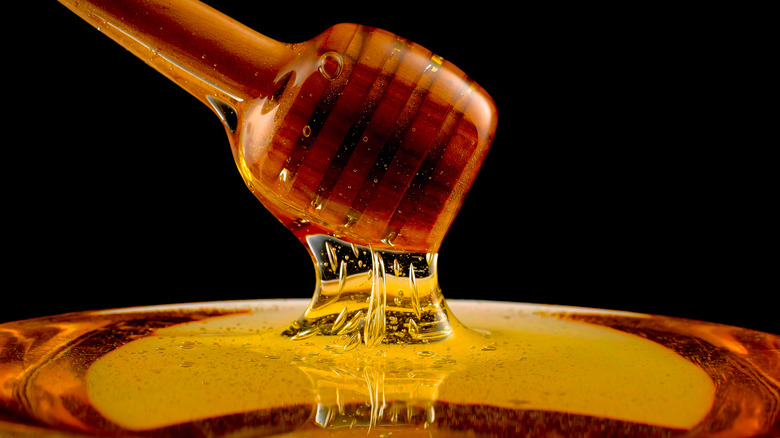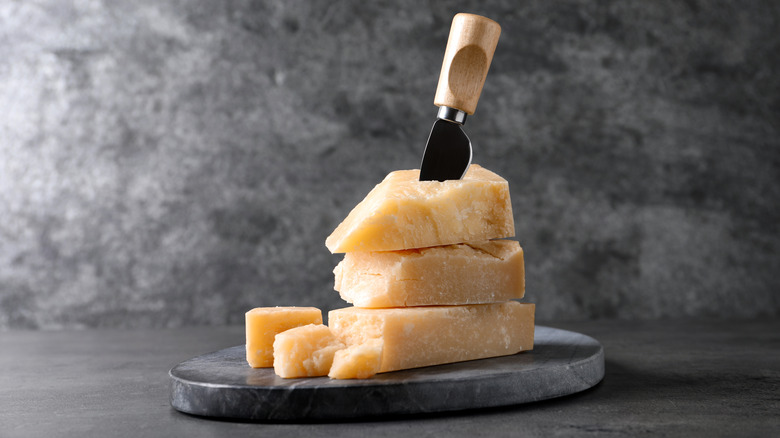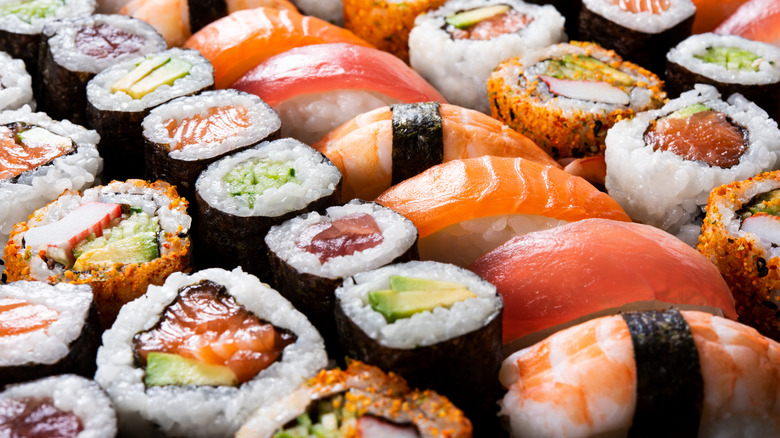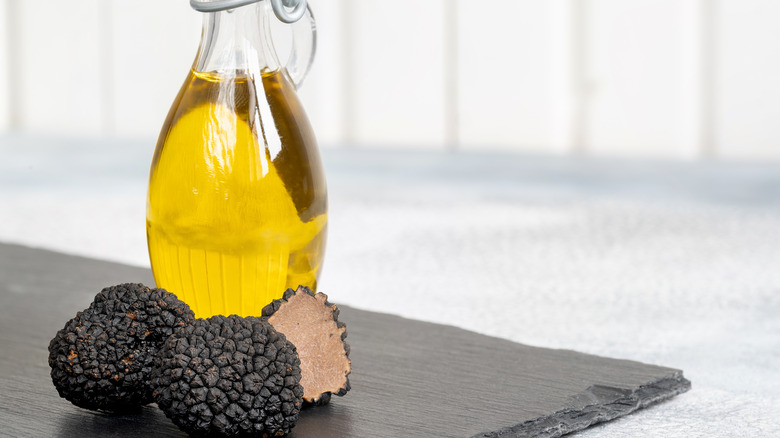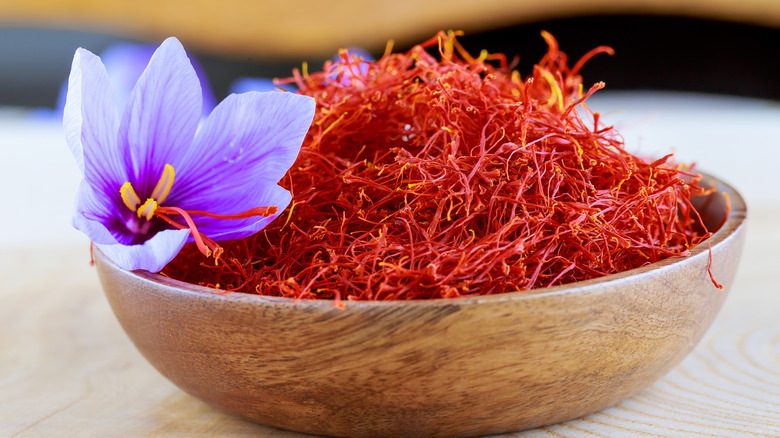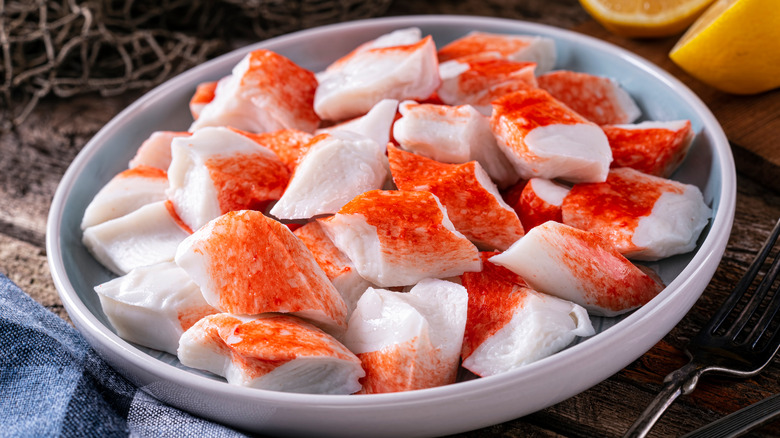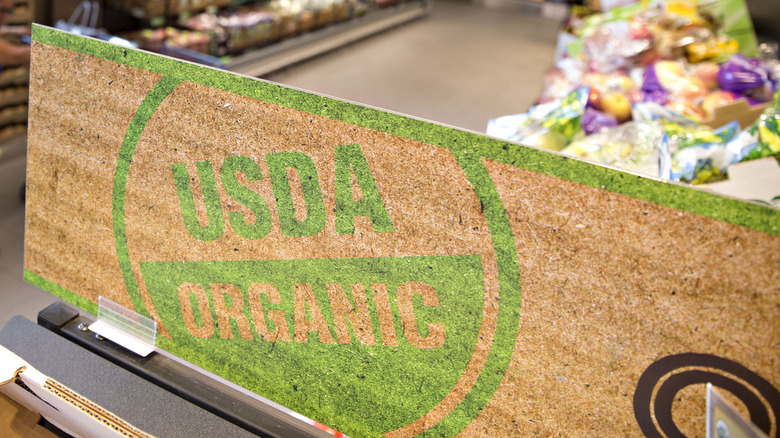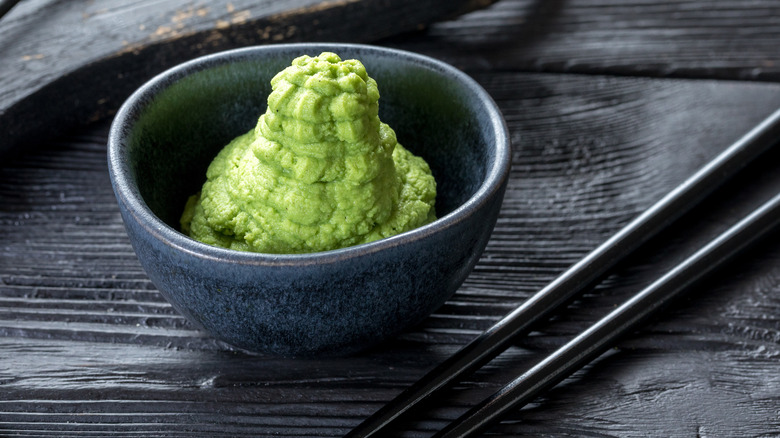Most Common Fake Foods To Watch Out For
Journalist and author Larry Olmsted exposed rampant fraud in the food industry in his 2016 book, "Real Food/Fake Food." In that book, Olmsted wrote, "I'm talking about a massive industry of bait and switch, where you get something other than promised."
Some of the most common foods we eat have either been intentionally mislabeled or adulterated. In legal terms, this means "if it bears or contains any poisonous or deleterious substance which may render it injurious to health." The CDC estimates that approximately 48 million people get sick from foodborne illness annually, but which foods specifically are responsible is mostly unknown. Olmsted claims that the seafood industry is "so rife with fakery, both legal and illegal, that it boggles the mind." As he was quoted by the New York Post, 91% of seafood is imported to the U.S., and the Food and Drug Administration (FDA) is only required to inspect 2 percent of that. But in 2013, the FDA inspected a pathetic less than half of 2 percent. "They're lucky if they inspect half of a percent," Olmsted said in an interview with CBS News. If you want to know what faked foods you need to watch out for, read on.
Extra virgin olive oil
Olive oil fraud is one of the most frequently reported frauds in the world (per Science Direct), and extra virgin olive oil (EVOO) is the most susceptible to being polluted with cheap vegetable oil or other lesser-grade olive oil. "60 Minutes" producer Guy Campanile reported that journalist Tom Mueller researched the olive oil industry and estimates that around 50% of the olive oil sold as EVOO in Italy and 75-80% of EVOO sold in the U.S. does not meet the legal grades for EVOO.
Campanile pointed out that the Mafia-controlled fraud often involves mixing Italian EVOO with lower quality olive oils from North Africa and Mediterranean countries. Or it may not even be olive oil, but sunflower oil or a nut oil that's been treated with chlorophyll and beto-carotene to smell and look like olive oil. The worst fraud that Mueller told The World, is when fraudsters make inedible olive oil with rotten olives, refining it so it's tasteless and odorless, and then "deodorizing" it with real olive oil. This type of deodorized olive oil, Mueller claims, is found in many low-grade olive oils in supermarkets. Some Italian olive farmers are trying to cut the Mafia out, but Campanile warns that if you think you're getting a bargain by buying EVOO cheap, it's probably not the real thing.
Filet mignon
Sure, filet mignon is tender, but not everybody thinks it's such a great steak. Almost all of the chefs interviewed by The Thrillist agree that filet mignon is flavorless and lacks the texture of better steaks. There may be another reason for its texture. It could actually be a wad of beef scraps compressed and held together with "meat glue." As reported by Gizmodo, it's a practice that's pretty common in restaurants that serve a lot of filet mignon every night.
Meat glue, officially known as transglutaminase, is a naturally occurring enzyme that can bind proteins together. But it's also made in a lab by cultivating bacteria from cow or pig blood plasma, although some "TG" can be plant-based. As reported by Syracuse.com, Betsy Booren, former vice president of scientific affairs at the American Meat Institute, said in an interview with KGO-TV that TG was used to glue together filet mignon scraps. "It gives chefs and specialists some flexibility to create a very nutritious and healthy product and add value to what ultimately, worst-case scenario, would just be thrown away."
Although TG was banned by the European Union in 2010, the USDA still allows it, and the FDA considers it to be safe. So if you're wondering how a restaurant can afford to charge such a cheap price for filet mignon, there's a chance you got served a fake steak.
Red snapper
In 2013, Oceana — the largest international consortium for restoring and preserving oceans — released a devastating report that seafood fraud — illegally substituting one seafood species for another — is rampant in the U.S. DNA testing determined that one-third of 1,215 samples analyzed were mislabeled. Red snapper had the highest level of mislabeling at 87 percent. Only seven of 120 samples purchased nationwide were actually red snapper.
Most often, tilapia was sold as snapper. In Eater, writer Larry Olmsted called red snapper the "poster child for fraud," claiming that when ordered in a restaurant, the real thing makes it to the plate on 6% of the time. Apparently, red snapper is pretty easy to fake. When its pretty red skin is removed and the fish is filleted, it looks like several other types of fish (via CNBC), meaning a cheaper fish can easily be substituted in its place, but you'll still pay the high-end price for snapper. Obviously, since most restaurants serve fish cooked and sauced, diners have no idea if a switch has been made. As DNA researcher Dr. Mark Stoeckle told Olmstead: "Just don't ever order red snapper."
Kobe beef
Unless you're dining at one of the 38 U.S. restaurants certified by Japan to sell Kobe beef, that beautiful piece of meat on your plate is probably some other, less-expensive beef. Kobe is a particular type of wagyu (which literally means "Japanese cow") that's only raised in the Hyogo Prefecture of Japan (via Robb Report). The Kobe Beef Association certifies about 5,000 cattle under very strict guidelines as real Kobe, and as Forbes reported, only 10 percent is exported, and the Kobe Beef Association tracks when and where it was exported. That's hardly enough Kobe beef to satisfy American appetites for the luscious, buttery beef.
But that didn't stop several high-end restaurants from falsely calling their steaks Kobe beef, as revealed in 2016 by "Inside Edition." Three-star Michelin restaurant Le Bernardin was one of the scammers. Inside Edition's reporter asked the manager for the Kobe certification, and though he acquiesced, he never came back. The next day the owner called, saying it had been a mistake, and they'd changed the menu item to Japanese wagyu. Other restaurants in New York and California that "Inside Edition" investigated were found selling steaks, burgers, and at one upscale place, a $17 hot dog, as Kobe beef. So if you see Kobe beef on a menu, it's fair game to ask to see the restaurant's certification.
Honey
Winnie The Pooh didn't need to doubt that the "hunny" in his honeypot was 100% pure ... but you might. According to Insider, honey is the third most faked food in the world (just behind olive oil and milk). A class-action lawsuit filed in 2021 by American beekeepers attempts to stop the flow of phony honey from Asia (via The Guardian). The beekeepers claim that two importers and two honey-packers have been in cahoots with True Source Honey in a scheme to certify adulterated honey as real honey.
China produces one-quarter of the worldwide output of honey, and the stuff is infamous for being made of cheap rice, corn, or beet syrup that's blended with honey. Using something called resin technology, honey fraudsters can filter honey so any additives, contaminants, or place of origin can be detected through testing. Kent Hietzinger is one of the lawyers who filed the lawsuit, and according to Vice, he tested 110 different honeys, and 70 of them had been adulterated. Bee America has several tests you can do at home to find out if that pricey honey you bought at the market is a fake. Or skip the store and buy directly from a local beekeeper.
Parmesan cheese
As reported by Bloomberg News, wood pulp (or cellulose) is a perfectly legal additive to prevent canned grated Parmesan from caking. The FDA considers cellulose to be safe as long as it's between 2% and 4 % of the total ingredients. However, Bloomberg tested several brands of canned Parmesan and found 3.8 to 8.8% of cellulose in their purportedly 100% Parmesan cheese. The boldest fraudster was Castle Cheese Inc. whose Parmesan products contained cheese (Swiss, mozzarella, and cheddar), but absolutely no Parmesan.
According to The Counter, there have been over 50 class-action lawsuits filed against Parmesan producers for marketing their cheese as 100% Parmesan. It seems obvious, then, that you should just buy a chunk of authentic Parmesan and grate it yourself. Unfortunately, counterfeit Parmesan generates $2 billion annually worldwide (per FoodBeast), and the amount of the fake cheese exported is 15 times more than authentic Parmesan that's been certified as a Protected Designation of Origin (PDO). In the U.S., however, there are no strict regulations or requirements, and domestic Parmesan can be made anywhere with varying quality and types of milk (via Serious Eats). The cellophane-wrapped triangles in every grocery dairy case can be tasty, but if you really want to taste real Parmesan that's actually from Parma, look for the PDO seal of authenticity.
Sushi
There are thousands of sushi restaurants in America, and it's more likely that you'll get fresher fish at an upscale place than you would at a convenience store. Maybe. Despite government regulations enacted in 2016, fish fraud is still widespread. Oceana released a report in 2019 that one in every five fish they tested was mislabeled, and one out of every three restaurants, grocery chains, or small markets sold mislabeled seafood.
Even worse, UCLA released a report in 2017 that out of 26 Los Angeles sushi restaurants tested, 47% sold mislabeled fish, which the report's author Paul Barber suspects were mostly intentional. DNA testing proved that the UCLA researchers were always served something else when they ordered halibut or red snapper.
Inside Edition's investigation of New York sushi restaurants was more disturbing. Sixty-eight percent of the fish ordered was different and of a cheaper variety. White tuna is often on a sushi menu, but there actually is no such fish. What you're getting instead is escolar, nicknamed the "Ex-Lax Fish" because of the severe digestion distress it causes when eaten. Another popular sushi is scallop, which author Dr. David Freeman claims are faked by cutting stingray, skate, or shark with a cookie cutter. Until Oceana's call to action is heeded, beware what sushi you order.
Truffle oil
Some people will pay astronomical prices for truffles. In 2007, a 1500 gram white truffle (roughly 3.3 pounds) sold for $330,000. Black truffles are cultivated in France and white truffles in Italy. Truffles can't be mass-produced, and although France planted the trees on which black truffles grow, the production of truffles has declined due to urbanization and climate change.
According to The Atlantic, truffles are so prized that truffle heists are fairly common. In the 1990s, olive oil purportedly infused with truffle bits was restaurant chefs' darling, and foodies couldn't get enough of it splashed on practically any dish (per The New York Times). Chefs don't use truffle oil as much these days, but there are plenty of truffle oils sold by specialty markets. Truffle oil, however, is a complete scam, since there isn't a speck of truffle in it. Instead, olive oil is flavored with a chemical, 2,4-dithiapentane, also known as bis methane, and its aroma closely mimics real truffles. But after the first couple of whiffs, the chemical odor is noticeable. In May 2017, four class-action suits were filed in New York and California for "unjust enrichment, negligent misrepresentation, and fraud" by truffle oil distributors, including Trader Joe's, which was eventually dismissed.
Saffron
As reported by the BBC, saffron is an essential ingredient for many international cuisines, and it's also added to medications and cosmetics. Known as "red gold," saffron is costly because of how labor-intensive it is to produce. Saffron comes from the saffron crocus, a violet flower with red stigmas, which must be meticulously plucked by hand. It's harvested in Iran, Greece, Morocco, and India. Because of its small production and high prices, saffron is an ideal commodity for criminal organizations to counterfeit.
In February 2021, Spanish authorities hauled in 17 members of a saffron-counterfeiting group (via OCCRP), who pocketed approximately 10 million Euros by selling Iranian saffron that had been mixed with other herbs, dyed with coloring that's banned in the U.S. and European Union, and relabeled as high-quality Spanish saffron.
According to Botanical Online, saffron is counterfeited by bulking up real saffron by adding minerals, oil, fat, other plant stigmas or petals, or other parts of the saffron crocus. Although the fake saffron isn't toxic (except when metal is added to the mix), it does damage the reputation and livelihood of actual saffron producers. If you want to test whether you've paid through the nose for the phony stuff, there are several tests you can do at home.
Crab stick
Crab stick is to crab what Velveeta is to cheese. They both resemble the real thing, but they certainly don't taste like it. That's not to say that crab stick (sometimes called krab) isn't seafood. It's proper name is surimi, which in Japanese means "ground meat." and according to Thrillist, it's been around for 900 hundred years when Japanese chefs created it as a means to preserve extra fish. Then in 1960, a Japanese chemist figured out how to extend surimi's refrigerated shelf life, which for some varieties, is now estimated to be 70 days to four months in its sealed package. Surimi is most often made from Alaskan pollack or Pacific whiting that's ground into paste and mixed with sugar, egg whites or flour, and preservatives (per The New York Times).
It's then processed, shaped, and colored to resemble cooked crab meat. No processed food is as nutritional as real food, and as Healthline reports, surimi has the same calories as crab but less than half the protein, substantially less Omega-3, and 12.7 grams of carbs, which includes added sugar and starch. Because it's so inexpensive, surimi often replaces crab in sushi, salads, sandwiches (like Subway's Seafood Sensation), and phony lobster rolls. If you've only eaten surimi, try real crab some time. We're betting you won't eat the imposter again.
Some organic food
According to the Organic Trade Association, organic product sales in the U.S. skyrocketed during the pandemic because more people were cooking at home. Hitting a record-breaking $61.9 billion in 2020, organic food is big business, which, in turn, means it's ripe picking for fraudsters. Three years earlier, The Washington Post conducted an investigation into organic fraud and found a shipment of 36 million pounds of ordinary, pesticide-treated soybeans had made its way from Ukraine to Turkey to Stockton, California, and along the route, were somehow transformed into "organic" soybeans, which increased their value by $4 million. By the time of the Post's discovery, 21 million of those phony organic soybeans had been distributed to consumers.
The Post found two other "organic" shipments of corn and soybeans — again originating from Turkey — that were intended as animal feed for USDA-organic beef and chicken, thus also potentially contaminating milk and eggs. Food Safety Net Services reports that a study about "organic" products from China revealed that 37% had pesticide residue.
In 2019, an Iowa farmer was sentenced to 10 years in prison for selling more than $142 million of fake organic animal feed to livestock farmers, who then unwittingly sold their USDA-certified organic products to the public (via The Counter). The USDA proposed new regulations for protecting and enforcing organic integrity. But for the time being, we just have to trust those little certified organic stickers are real.
Wasabi
As reported by The Washington Post, the president of Pacific Coast Wasabi — marketed as North America's only commercial grower of authentic wasabi — claims that 99% of wasabi sold in U.S. sushi restaurants is fake. Even in Japan, it's estimated that 95% is phony, too. Wasabia japonica — the root of which is ground to make wasabi paste — is a famously finicky semi-aquatic plant that requires tons of water and arduous cultivation. It's been called the world's most difficult plant to grow commercially.
So what is that green gob on your sushi plate? It's more than likely a mix of horseradish, mustard, and food coloring. Fake wasabi is sold in powdered form, and the sushi chef adds water to make the wasabi paste. If you're used to wasabi's notorious burning sensation on your tongue, you'd be surprised that authentic wasabi is totally different. Freshly grated, wasabi has an herbal aroma and a sweet taste, followed by a quick, spicy bite. Wasabi supply can't meet wasabi demand, which means the real wasabi is expensive, and a sushi restaurant can't afford to give it out for free. You can ask if the sushi chef has real wasabi on hand, but you'll pay extra for it.
